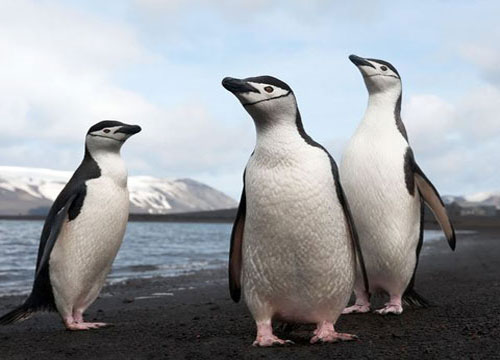Antarctic penguins fell seriously
The loss of half of the penguins in the past three decades shows the crisis in the Antarctic marine life, including phytoplankton, mollusks, penguins and whales.
The cause of the decline in the number of penguins may be due to the shortage of mollusks - the main food of penguins - as well as the return of hungry whales.

The conical wings gather on the coast in Port Foster, Deception Island, Antarctica (Source: NATGEO ).
Wayne Z.Trivelpiece, a marine biologist from La Jolla, California, has followed the territory of the conical penguin and Adélia since the mid-1970s. He discovered that, very Few penguins survived their first winter because it was difficult to find food.
" The survival rate in the 1970s was half, but by the mid-1980s it was only 1/10 , " Trivelpiece said.
"Direct measurement methods for krill show that their numbers are 80% less than 20 years ago. Therefore, the possibility of young penguins finding enough food to survive in the months of independence First dropped a lot ".
Molluscs are very small animals like shrimp, have a very large quantity and are a major part of food in Antarctica. Molluscs eating single-celled plants called phytoplankton become the food source of marine animals, including penguins.
According to Trivelpiece, the decrease in the number of mollusks in the area may be due to the air temperature of 5-6 degrees C higher than in 1940 and 1950.
An increase in temperature causes the ice to not form, leading to a decrease in phytoplankton below the ice. Krill thus lacks food during the winter after they spawn the previous summer. And when there is no food, krill does not survive.
In addition, the decline in the population of toothless whales such as humpback whales also plays a significant role. Fish hunting in the 19th and early 20th centuries seriously affected the number of species and seemed to have created a golden age for penguins.
" Although there is not enough data since the 1930s, perhaps the period 1930 - 1970 was the time of penguin outbreaks because they are no longer competing with whales , " Trivelpiece said. In the 1930s there were about 100,000 penguins and increased to 500,000 - 600,000 in the 1970s.

Humpback whales are competitors for penguin mollusk food sources in Antarctica (Photo: animals )
According to Steve Emslie, a seabird researcher, chemical analysis of bird eggs shows that Adélie penguins are fish eaters before the number of whales decreases. In the past 100 years, mollusks have been included in their diets, when the whale has died and the amount of mollusks has exploded.
Scientists are wondering whether the decline of mollusks makes penguins switch to alternative fish diets?
- The secret of not freezing of Antarctic penguins
- The penguin bunched up to warm the cubs
- Why are Antarctic penguins afraid of the dark?
- Thousands of emperor penguins in Antarctica disappeared after a night
- Antarctic emperor penguins doubled
- New discovery about the existence of Antarctic penguins
- The secret of penguins
- Discovered a rare species of penguin in Antarctica
- Seals with penguins - the most fruitful love of the earth appeared
- Why do hundreds of Antarctic penguins turn into mummies?
- Emperor penguins can disappear forever
- What will be the fate of the emperor penguin?
 Animal 'suffering' after hibernation
Animal 'suffering' after hibernation Why do goats climb well?
Why do goats climb well? Scientists were surprised to see chimpanzees eating turtles
Scientists were surprised to see chimpanzees eating turtles Giant catfish died deadly due to drought in Thailand
Giant catfish died deadly due to drought in Thailand